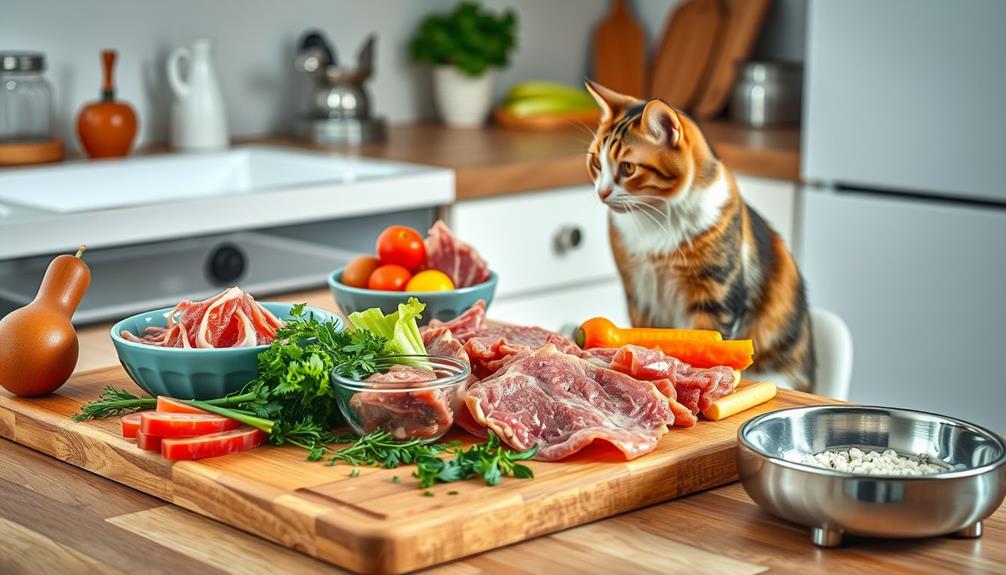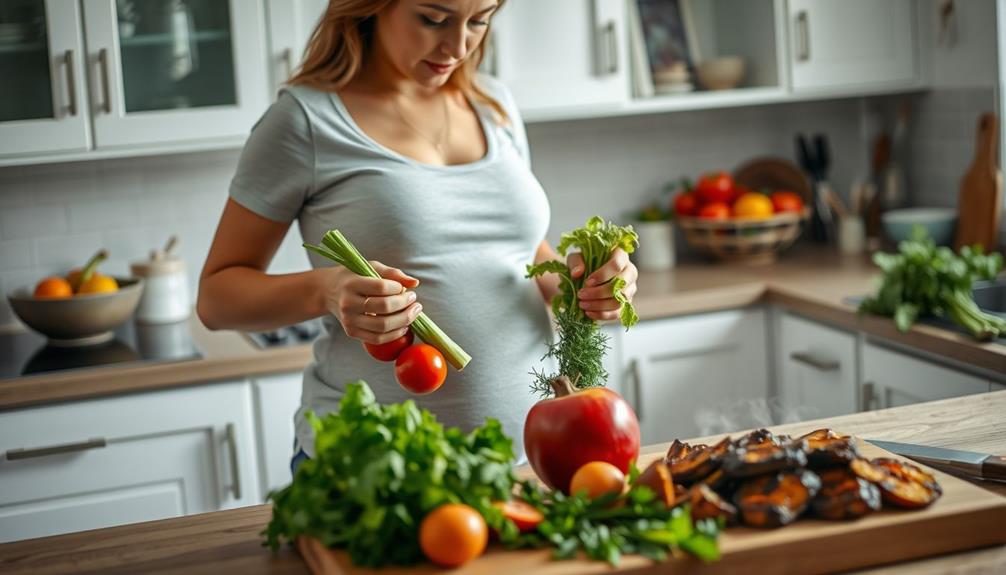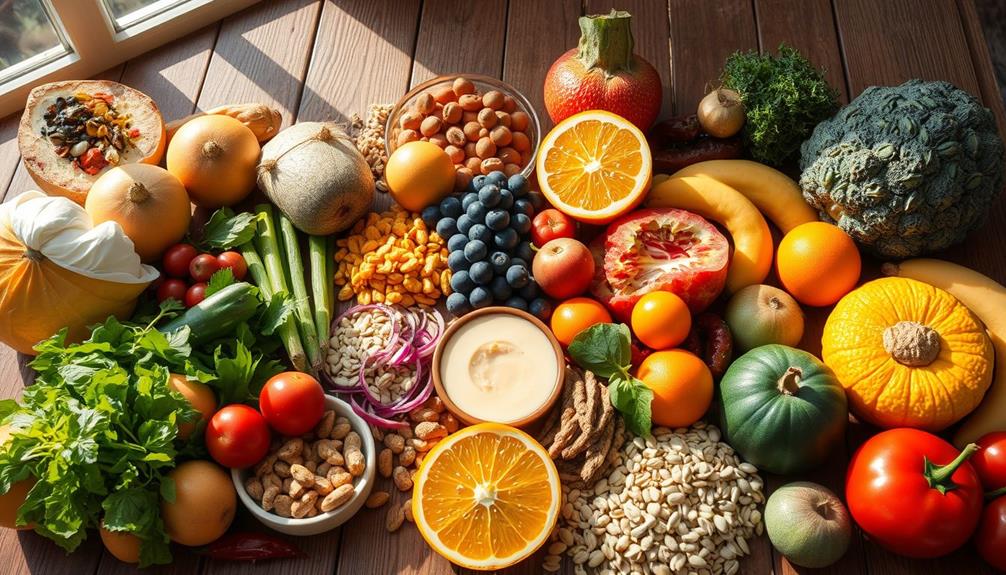Feeding your cat raw food can greatly improve their health, leading to a shinier coat and better digestion. Start by sourcing raw food from reputable suppliers and keep it stored properly in the freezer. Shift slowly using a two-bowl system or a straight swap method, monitoring your cat's response. Verify you're providing a balanced diet with muscle meats, organ meats, and raw meaty bones for essential nutrients. Pay attention to proportions based on your cat's weight and adjust as needed. By following these expert tips, you can help your feline thrive on a raw diet while exploring more effective strategies for success. Consider consulting with a veterinarian or animal nutritionist to ensure you’re meeting your cat’s specific dietary needs. Additionally, research and educate yourself on the potential risks and benefits of raw food for cats. With the right knowledge and preparation, raw food can be a beneficial and nutritious option for your feline friend.
Key Takeaways
- Transition to raw food gradually using a two-bowl system or straight swap method to help your cat adjust easily.
- Use RawSAFE accredited suppliers for sourcing raw food and store it at -18°C (0°F) or lower for safety.
- Incorporate a variety of meats, organ meats, and raw meaty bones to ensure a balanced diet rich in essential nutrients.
- Monitor your cat's weight and overall health regularly, adjusting portions as needed to maintain optimal nutrition.
- Engage with fellow cat owners and utilize educational resources for ongoing support and tips on raw feeding practices.
Understanding Raw Cat Food
Understanding raw cat food is significant for any cat owner looking to improve their pet's diet. This feeding approach mimics a feline's natural diet, featuring high-quality meat, organs, and bones along with essential nutrients like taurine.
When you choose raw cat food, you're opting for a Biologically Appropriate Raw Food (BARF) diet, which emphasizes a balanced intake of these ingredients while avoiding artificial additives and fillers. Additionally, it's important to take into account that certain dietary adjustments can be beneficial for your cat's overall health, similar to how gout nutrition guides suggest specific foods to manage symptoms.
By feeding your cat high-quality raw food, you promote better nutrient absorption and support overall health. It's critical to select formulations that cater to your cat's life stage, whether they're a spirited kitten or a senior requiring special nutritional support.
Unlike processed cat foods, which might contain harmful ingredients, raw diets focus on species-specific components that enhance digestive health and prevent nutritional deficiencies.
Safety plays an essential role in raw feeding, too. Look for products with RawSAFE accreditation, ensuring that the raw food meets strict hygiene standards throughout the supply chain.
Benefits of a Raw Diet

When you switch your cat to a raw diet, you're likely to notice a range of health benefits that come from a more natural feeding approach. Raw diets, particularly the BARF method, mirror your cat's ancestral eating habits, providing high-quality meat, organs, and bones fundamental for their health. You'll find improvements in coat condition, dental health, and immune function, thanks to the nutrient-dense nature of these diets.
The table below highlights key health benefits:
| Health Benefit | Description |
|---|---|
| Enhanced Coat Condition | Improved shine and reduced shedding |
| Better Digestive Health | Easier digestion and nutrient absorption |
| Boosted Immune Function | Strengthened defenses against illness |
The inclusion of organ meats and bones supplies essential vitamins and minerals like taurine, calcium, and phosphorus. These nutrients are important for energy and metabolic regulation. When done correctly, a balanced raw diet eliminates artificial additives and fillers, leading to a more species-appropriate and digestible meal for your feline friend. Embrace the shift to reap these health benefits!
Safety and Handling Practices
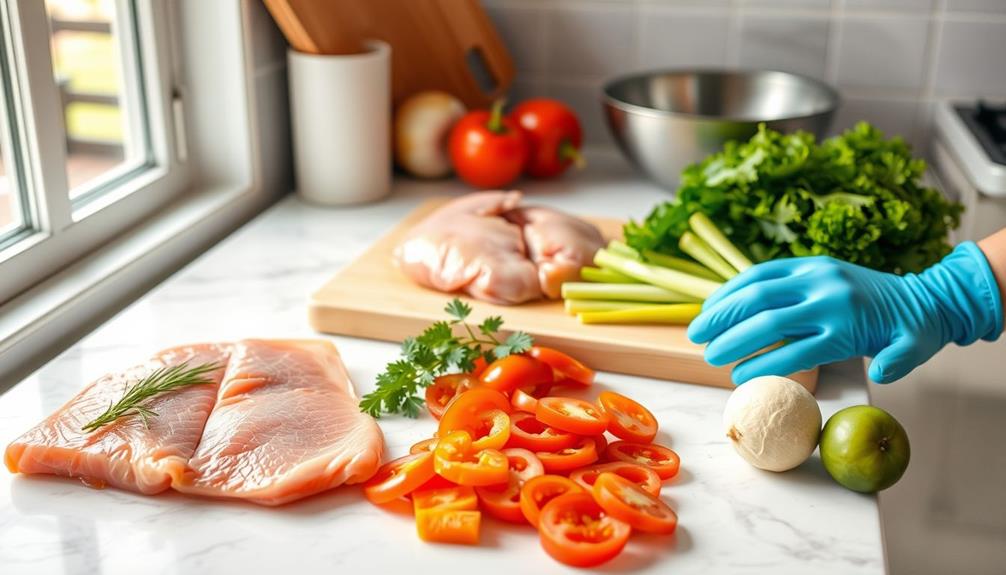
Feeding your cat a raw diet can bring numerous health benefits, such as improved digestion and healthier skin, but it's important to prioritize safety and handling practices to protect both you and your pet.
Start by sourcing raw pet food from a RawSAFE accredited supplier. This guarantees the food adheres to strict food safety standards, minimizing the risk of harmful bacteria. Additionally, consider supplementing the raw diet with safe snacks, like fresh vegetables, that can enhance nutritional value and variety safe snacks for pets.
When it comes to storage, keep frozen portions at -18°C (0°F) or lower. Once thawed, refrigerate the food and use it within 24 hours. To prevent cross-contamination, always use separate utensils and cutting boards for raw food preparation. This simple step can greatly reduce the risk of spreading bacteria to other foods.
Don't forget to wash your hands thoroughly before and after handling raw food. Clean surfaces and utensils with hot, soapy water to create a safe environment.
Transitioning to Raw Feeding
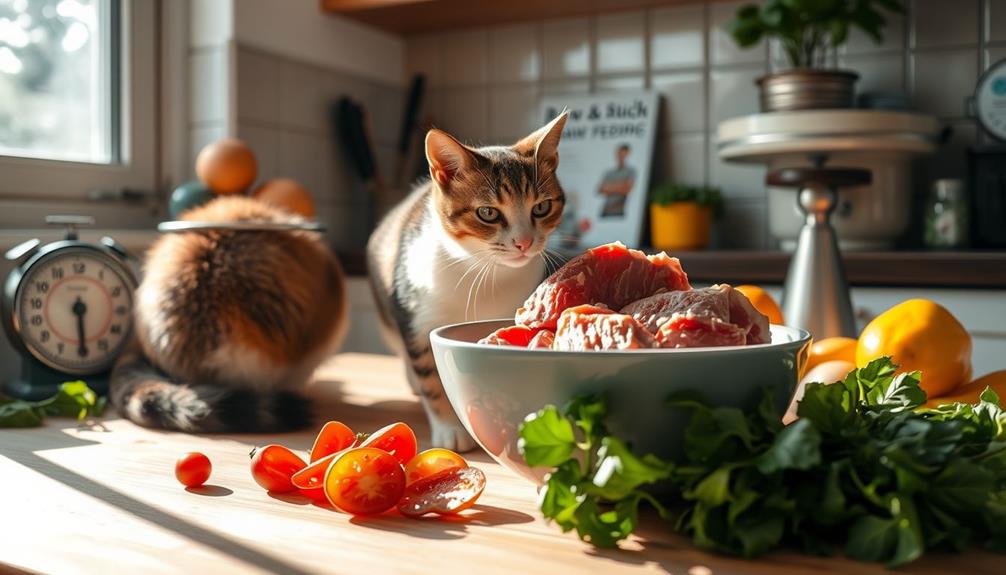
When shifting your cat to a raw diet, choosing the right method is key, whether it's the two-bowl system or a straight swap.
It's important to monitor your cat's emotional responses during this change, as stress can impact their willingness to try new foods. If your cat's a picky eater, you'll need to be patient and creative in introducing the new food.
To guarantee a smooth shift, consider observing their developmental patterns, as a gradual approach can help them adjust better to the new diet emotional and psychological growth.
Keep an eye on their weight and adjust portions as needed to guarantee a smooth shift.
Choosing Transition Method
Shifting your cat to a raw food diet can often feel intimidating, but choosing the right method makes a significant difference. You have two main options for altering your cat to raw feeding: the straight swap method or the gradual method.
With the straight swap, you immediately replace kibble with raw food. This approach can work well, but some cats might struggle with the sudden change. The gradual method introduces eating raw alongside their current kibble, allowing your cat to adjust over time.
It's essential to recognize that just like with human diets, a sudden change in food can sometimes lead to digestive discomfort, similar to how juice diets may cause gastrointestinal issues during initial phases juice diets impact digestion.
Be patient and flexible during this alteration. Some cats take longer to adapt, so you may need to try different meats or textures to find what your cat prefers.
Keep a consistent feeding schedule while slowly decreasing kibble intake, which can help your cat adjust to their new natural diet.
It's vital to monitor your cat's health closely during this period. Minor digestive issues may arise but often resolve on their own. If you notice any serious concerns, consult your veterinarian.
Don't forget to track your cat's weight and overall health to make necessary adjustments based on their activity level and individual needs.
Addressing Picky Eaters
Shifting a picky eater to a raw food diet can be a challenge, but with the right approach, you can encourage your cat to embrace new flavors. Start by mixing small amounts of raw cat food into their regular kibble, gradually increasing the raw portion. Using enticing flavors like shredded chicken or fish can make feeding raw more appealing.
Consider the "two bowl" method, where you place one bowl with raw food and another with kibble. This allows your cat to choose while you slowly reduce the kibble over time. Be patient; it might take several attempts and days for your cat to accept the new diet, especially if they're used to dry food.
Here's a quick reference table to help you adapt:
| Step | Action | Purpose |
|---|---|---|
| 1. Start Slowly | Mix raw with kibble | Encourage acceptance |
| 2. Use Enticing Flavors | Add chicken or fish | Attract picky eaters |
| 3. Two Bowl Method | Offer both raw and kibble | Allow choice |
| 4. Monitor Digestive Response | Adjust pace as needed | Guarantee comfort and health |
Remember to monitor your cat's digestive response and adjust the adaptation pace to avoid any issues.
Key Nutritional Components
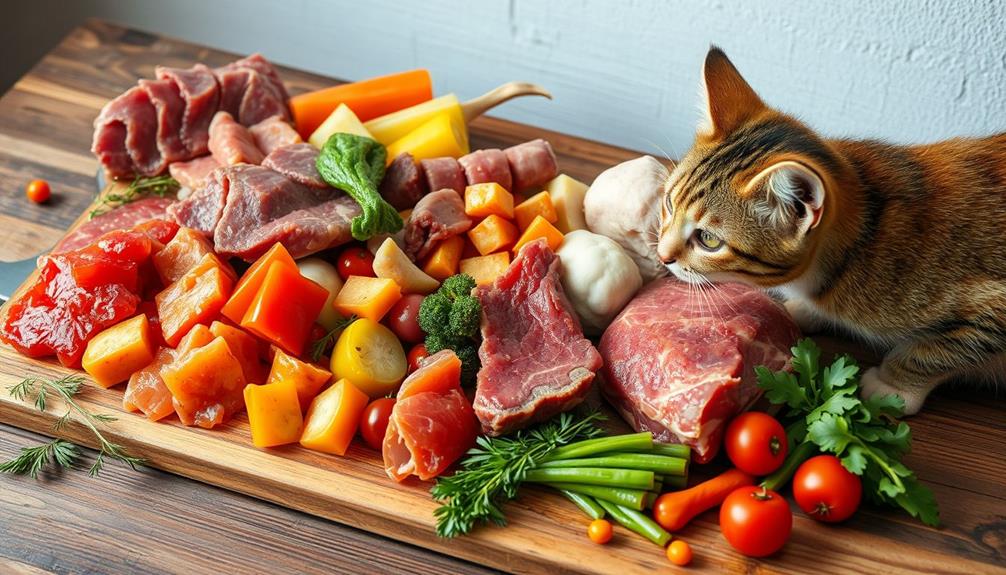
When feeding your cat raw food, understanding the essential nutrients is fundamental for their health. A balanced diet not only provides the protein they need but also includes critical vitamins and minerals to prevent deficiencies.
Incorporating a variety of meats can help mimic their natural diet, ensuring they receive the necessary amino acids and fatty acids. Additionally, considering their hydration needs is important, as cats may require extra moisture in their diet to support kidney health maintenance.
Essential Nutrients Overview
A well-balanced raw food diet for cats provides essential nutrients that support their overall health and well-being. To achieve this, you'll want to include a variety of whole foods in your cat food regimen.
Start with raw meaty bones, which are essential for supplying calcium and phosphorus—key components for strong bones and teeth. Incorporating healthy dog snacks can inspire you to guarantee all pets receive nutritious treats, promoting their health.
Next, incorporate muscle meats like chicken and beef. These are excellent sources of high-quality protein and essential minerals that help with energy levels and metabolic functions.
Don't forget about organ meats! Chicken hearts and beef liver are packed with crucial nutrients, including taurine, an essential amino acid that promotes heart health and overall wellness in felines.
Adding secreting organs, such as kidneys, can serve as a natural multivitamin, offering a wide range of essential vitamins and minerals your cat needs.
Balanced Diet Importance
Maintaining a balanced raw diet is fundamental for your cat's health and well-being. A well-rounded diet helps provide nutrients that support their unique physiological needs, especially since they're obligate carnivores.
To guarantee your cat thrives, focus on incorporating a variety of protein sources and essential nutrients. Additionally, just as with body piercings, proper care and hygiene are significant in preventing any potential issues during dietary shifts, especially when introducing new protein sources piercing care and hygiene.
Here are three key components to include in their raw diet:
- Muscle Meats: These are your primary protein source, important for muscle development and energy.
- Raw Meaty Bones: They provide calcium and phosphorus, which are essential for bone health and immune function.
- Organ Meats: Rich in crucial nutrients like taurine, organ meats support heart and eye health.
Incorporating these elements into a balanced raw diet for cats mimics whole prey, guaranteeing a thorough nutrient profile.
Regularly assess and adjust your cat's diet based on their age, health, and activity level to prevent deficiencies. Remember, cats need a wide range of nutrients, so variety is key.
Meal Preparation Tips
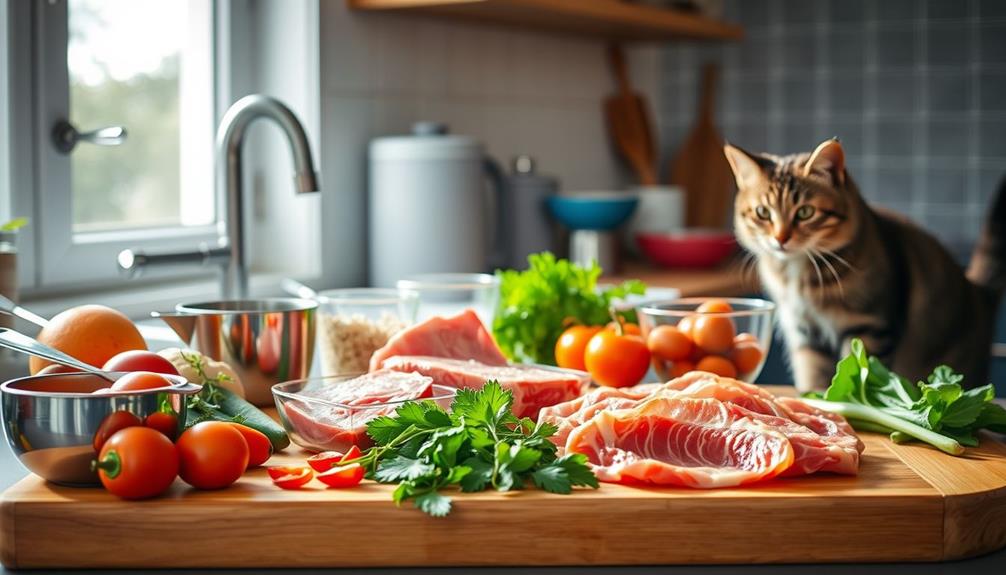
Preparing raw meals for your cat can feel intimidating, but with the right tools and a bit of planning, it becomes much easier. Start by gathering essential utensils like a knife, cutting board, and kitchen scale. These will help you portion meals accurately and guarantee safe preparation.
A complete raw meal typically contains around 195 calories, so it's vital to portion based on your cat's weight and dietary needs. Incorporating ingredients like essential oils for health benefits can also enhance your cat's overall well-being. Consider freezing pre-portioned meals to simplify daily feeding and maintain freshness. This way, you can easily thaw out what you need each day.
When it's time to feed your cat, don't forget to incorporate natural ingredients, such as raw bones, for added nutrition. You might also enhance your cat's digestive health by adding probiotics like kefir to their meals, aiding in nutrient absorption.
Tailor your feeding schedule to your cat's preferences. Offer meals in multiple feedings throughout the day to encourage acceptance of their new raw diet. By following these meal preparation tips, you'll guarantee that feeding your cat raw food isn't only manageable but also enjoyable for both of you. Consider incorporating a variety of proteins into their diet to ensure they are getting a well-rounded nutritional intake. Additionally, consult with your veterinarian to ensure you are providing the right balance of nutrients for a healthy raw food diet for cats. With patience and persistence, you can help your cat transition to a raw food diet and ultimately improve their overall health and well-being.
Addressing Nutritional Gaps
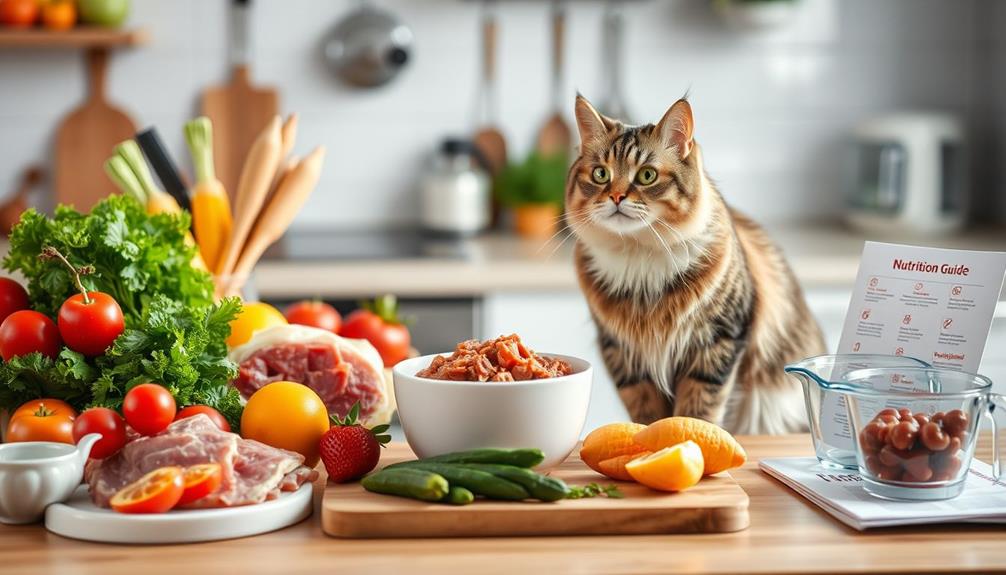
Addressing nutritional gaps in your cat's raw diet is crucial for their overall health and well-being. Many raw diets can fall short in key nutrients like omega-3 fatty acids, vitamin E, and iodine. To guarantee your feline friend gets a balanced diet, consider these additions: Incorporating diverse protein sources, such as different brewing methods, can enhance nutritional value and flavor.
- Incorporate salmon: This fish is rich in omega-3 fatty acids and vitamin D, both essential for maintaining peak health. Your cat will love the flavor, too!
- Add green tripe: This nutrient-dense food provides significant levels of manganese and iron, effectively addressing nutritional gaps in your cat's diet.
- Use kelp powder and vitamin E oil: Kelp helps fill iodine deficiencies, while vitamin E oil guarantees your cat gets enough of this important antioxidant, supporting their immune system.
Regularly assess your cat's diet against NRC guidelines to make necessary adjustments.
By being proactive about these nutritional gaps, you'll help support your cat's long-term health and wellness.
Community and Resources

Connecting with fellow cat owners is invaluable when shifting to a raw food diet. Engaging with community channels like The Pack allows you to share experiences, seek advice, and connect with experts who can guide you in feeding your cat the best raw meals.
Additionally, fostering a digital-friendly environment at home can enhance your ability to research and connect with other pet owners. Social media platforms are great resources for ongoing updates and tips on raw feeding practices, creating a supportive environment for pet parents.
You'll find a wealth of articles that explore the benefits of raw cat food, detailed feeding guides, and health monitoring resources tailored to your cat's unique needs. These resources can help you understand the BARF diet and its advantages, making certain that you make informed decisions.
Additionally, subscription services for tailored pet food options simplify maintaining a balanced raw diet. They make it easier for you to provide your cat with nutritious meals without the hassle of sourcing ingredients yourself.
Continuous education on pet well-being and dietary choices is key, and these community resources make sure you stay updated on the latest nutritional research and best practices. Embrace these connections, and you'll feel more confident in your journey to feed your cat a raw diet.
Monitoring Your Cat's Health
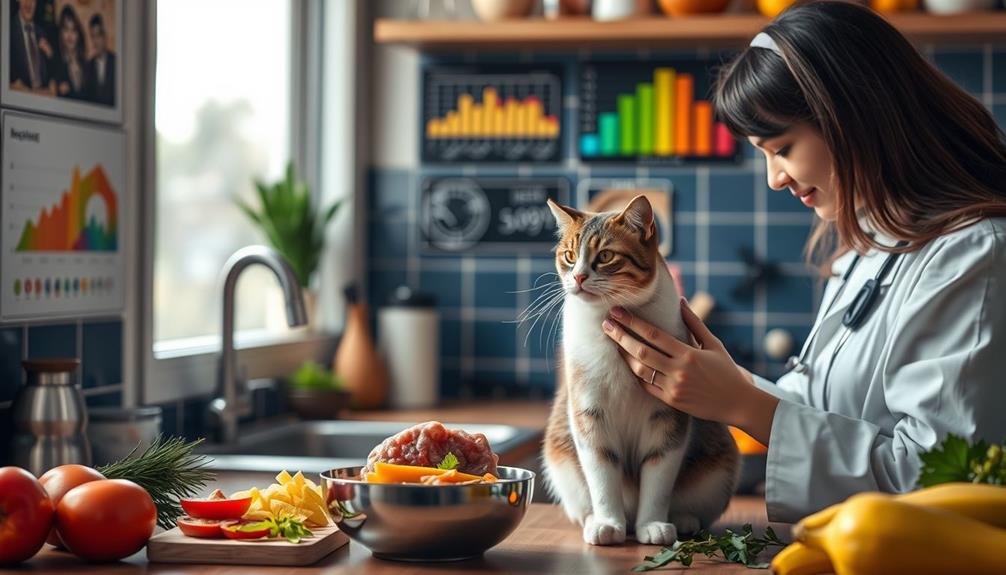
Monitoring your cat's health during the shift to a raw food diet is essential for guaranteeing their well-being. As you make this change, keep an eye on several key factors to assess how well your cat is adapting.
- Weight Management: Regularly monitor your cat's weight and adjust portions to maintain a daily intake of about 2.5% of their body weight. This helps prevent obesity and other health conditions.
- Coat Condition: A shiny, healthy coat often indicates a well-balanced raw diet. Confirm the food you provide is rich in essential fatty acids and nutrients.
- Digestion and Stool Quality: Observe your cat's digestion closely. Pay attention to their stool quality—firm and well-formed stools indicate a successful dietary change.
Additionally, track any changes in energy levels and behavior; improvements can signal that the raw diet positively impacts your cat's health.
Don't forget to schedule regular veterinary check-ups, as these can help identify any deficiencies or imbalances through blood tests.
Frequently Asked Questions
How to Safely Feed Raw Cat Food?
To safely feed raw cat food, source it from accredited suppliers, store it properly, use separate utensils, serve at room temperature, and discard leftovers after two hours. Educate yourself on safe handling practices for best results.
How Can I Make My Raw Food More Appealing to My Cat?
To make raw food more appealing, mix it with their current diet, warm it slightly, and introduce varied protein sources. Adding enticing toppings like freeze-dried meat or catnip can also encourage your cat to try it.
How Do I Transition My Cat to a Raw Food Diet?
Shifting your cat to a raw food diet can feel like climbing Mount Everest, but it's doable! Start slow, monitor their response, and adjust as needed. Patience is key to keeping your feline happy and healthy.
How to Balance a Cat's Raw Diet?
To balance your cat's raw diet, mix 70-80% muscle meat, 10-15% bones, and 10-15% organ meats. Monitor their health, adjust based on individual needs, and consider supplements for any nutrient gaps.
Conclusion
Feeding your cat a raw diet can be rewarding and fulfilling. By understanding the benefits, practicing safe handling, and shifting thoughtfully, you can nourish your feline friend with high-quality nutrition. With proper meal preparation, attention to nutritional gaps, and regular health monitoring, you'll set the stage for a vibrant, thriving cat. Embrace the journey, explore new recipes, and enjoy the bond that grows as you both discover the world of raw feeding together.

